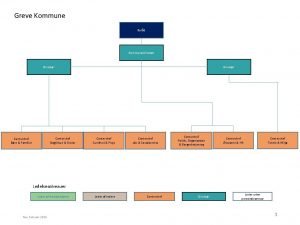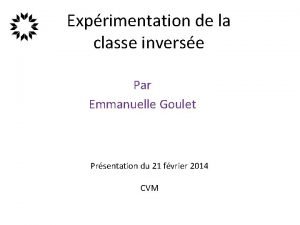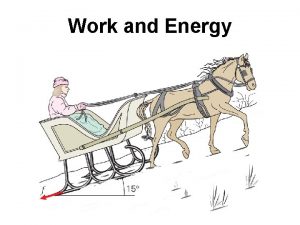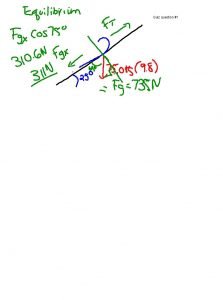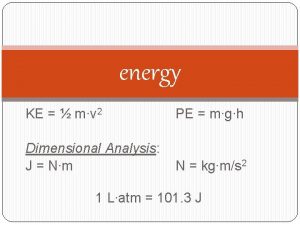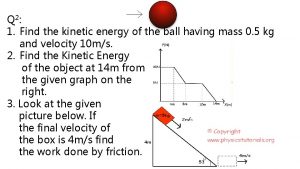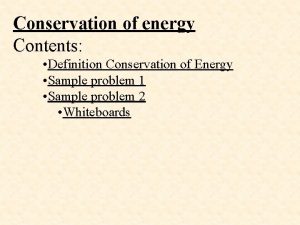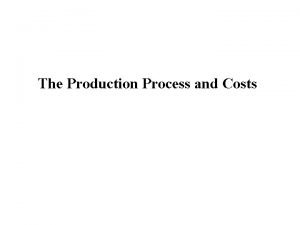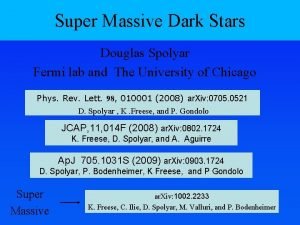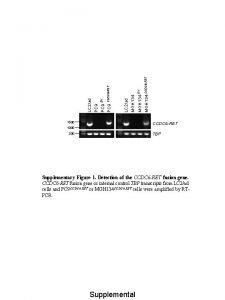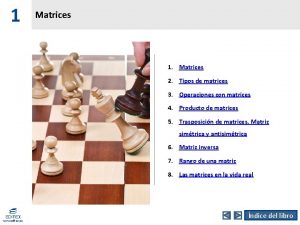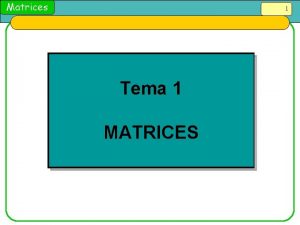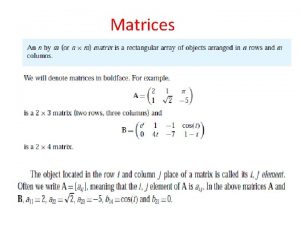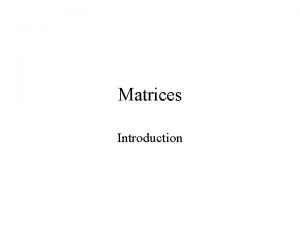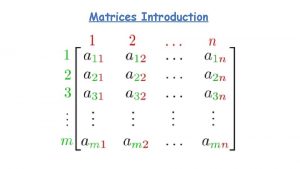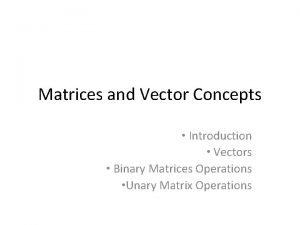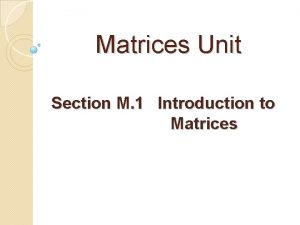Introduction to Matrices Douglas N Greve grevenmr mgh























































- Slides: 55

Introduction to Matrices Douglas N. Greve greve@nmr. mgh. harvard. edu

Why Matrices? • Simplifies notation • Simplifies concepts • Grounding for general linear model (GLM) • Simplifies implementation (eg, matlab, octave) • Optimization

What is the matrix? • A matrix is a table of numbers, like a spread sheet • Each entry is called an “element” • There is a value in each element (no empty cells) • Elements can be whole numbers, positive, negative, fractions, real, imaginary, symbolic variables 2 M= p 4 y 3. 3 i -7. 4 M M

Parts of Matrices • Size/Dimensions • Elements • Groupings of Elements • Diagonals • Triangles • Vectors

Matrix Size/Dimension • Number of Rows • Number of Columns • Rows-by-Columns (Rowsx. Cols) 2 p 4 y 2 4 y 3. 3 i -7. 4 p 1 x 1 2 x 3 2 p 2 x 1 1 x 3

Scalar versus Matrix • Scalar is just a number or value • No dimension or size g = -1 No brackets No dimension Not a 1 x 1 g = [-1] 1 x 1

Matrix Element • Indicated by its row and column number • Scalar value M= 2 p 4 M(row, col) y 3. 3 i -7. 4 (1, 1) (1, 2) (1, 3) (2, 1) (2, 2) (2, 3) M(i, j) 2 x 3 Mij M(2, 3) = -7. 4

Diagonals Row = Column + Offset 7 8 9 1 3 5 7 8 9 2 4 6 1 3 5 2 4 6 Row = Column - 2 (Second Upper Diagonal) Row = Column - 1 (First Upper Diagonal) 3 x 3 } Row = Column + 0 (Main Diagonal) Row = Column - 1 (First Lower Diagonal) Row = Column - 2 (Second Lower Diagonal) } Off-Diagonals

Triangles 2 4 6 1 3 5 7 8 9 Upper Triangle 3 x 3 Lower Triangle

Vector • Special Type of Matrix • Number of Rows or Columns = 1 • Often given lower-case variable names 2 4 y 1 x 3 Row Vector 2 p 2 x 1 Column Vector

A matrix consists of vectors 2 p 4 4 y 3. 3 i -7. 4 x 3. 3 i -7. 4 Two 1 x 3 row vectors 2 p 2 x 3 4 x 3. 3 i -7. 4 Three 2 x 1 column vectors

Special Matrices • Square • Diagonal • Identity • Triangular • Symmetric • Toeplitz

Square Matrix • Rows = Columns 2 p 4 3. 3 i p 2 x 2 1 x 1

Diagonal Matrix • All off-diagonal elements = 0 • M(i, j)=0 if i != j 2 0 0 0 3 0 0 0 9 3 x 3

Identity Matrix • Main diagonal has all 1 s • All off-diagonal elements = 0 • Square • Symbol “I” 1 0 I= 0 0 1 0 0 0 1 3 x 3 • Any matrix multiplied by the identity is itself

Triangular Matrices 2 4 6 2 0 0 0 3 5 1 3 0 0 0 9 Upper Triangular – all values below the main diagonal are 0 3 x 3 7 8 9 Lower Triangular – all values above the main diagonal are 0 3 x 3

Symmetric Matrix • M(row, col) = M(col, row) • Reflect across main diagonal • Square 2 4 6 4 3 5 6 5 9 3 x 3

Toeplitz Matrix All elements on a diagonal are the same 2 4 6 2 4 1 2 7 1 2 3 x 3 7 1 3 x 2 A causal, time invariant linear system is represented by an upper triangular Toeplitz matrix

Ones Matrix • All elements are 1 • Any number of rows or columns 1 1 1 1 1 2 x 3 1 x 1 1 1 2 x 1 1 x 3

Zeros Matrix • All elements are 0 • Any number of rows or columns 0 0 0 0 0 2 x 3 1 x 1 0 0 2 x 1 1 x 3

Matrix Operations • Addition/Subtraction • Vector Multiplication • Matrix Multiplication • Multiplication by scalar • Transpose • Trace • Inverse • Pseudo Inverse

Matrix Addition/Subtraction • Element-by-Element Addition/Subtraction • Size of two matrices must be the same • C(row, col) = A(row, col) +/- B(row, col) C = A + B (your first matrix equation!) A= 2 4 6 1 3 5 C= B= 2 x 3 0 7 9 1 -2 3. 3 2 11 15 2 1 8. 3 2 x 3

Vector Multiplication • One Row Vector and One Column Vector • Same length, Results in 1 x 1 • Inner Product, Dot Product, “Scalar” Product • Like a correlation • “Multiply and accumulate” x= 2 4 6 y= z = x. y= x*y = S xi*yi 1 x 3 0 1 7 3 x 1 1. 2 4 6 2. * * * 3. 0 1 7 4. 0+4+42 = 46

Matrix Multiplication • Series of vector multiplications • Same “inner dimension” A= C=A*B = 2 4 6 1 3 5 B= 2 x 3 c 11 c 12 c 13 c 14 c 21 c 22 c 23 c 24 0 4 2 8 1 5 6 2 3 7 9 3 3 x 4 cij=Arowi*Bcolj 2 x 4 Dimensions: (2 x 3) *(3 x 4)=(2 x 4)

Matrix Multiplication • Series of vector multiplications • Same “inner dimension” A= C=A*B = 2 4 6 1 3 5 B= 2 x 3 c 11 c 12 c 13 c 14 c 21 c 22 c 23 c 24 0 4 2 8 1 5 6 2 3 7 9 3 c 11= 2 x 4 2 4 6 0 1 3 2*0+4*1+6*3= 22 3 x 4

Matrix Multiplication • Series of vector multiplications • Same “inner dimension” A= C=A*B = 2 4 6 1 3 5 B= 2 x 3 22 c 13 c 14 c 21 c 22 c 23 c 24 0 4 2 8 1 5 6 2 3 7 9 3 c 12= 2 x 4 2 4 6 4 5 7 2*4+4*5+6*7= 70 3 x 4

Matrix Multiplication • Series of vector multiplications • Same “inner dimension” A= C=A*B = 2 4 6 1 3 5 B= 2 x 3 22 70 c 13 c 14 c 21 c 22 c 23 c 24 0 4 2 8 1 5 6 2 3 7 9 3 c 13= 2 x 4 2 4 6 2 6 9 2*2+4*6+6*9= 82 3 x 4

Matrix Multiplication • Series of vector multiplications • Same “inner dimension” A= C=A*B = 2 4 6 1 3 5 B= 2 x 3 22 70 82 c 14 c 21 c 22 c 23 c 24 0 4 2 8 1 5 6 2 3 7 9 3 c 14= 2 x 4 2 4 6 8 2 3 2*8+4*2+6*3= 42 3 x 4

Matrix Multiplication • Series of vector multiplications • Same “inner dimension” A= C=A*B = 2 4 6 1 3 5 B= 2 x 3 22 70 82 42 c 21 c 22 c 23 c 24 0 4 2 8 1 5 6 2 3 7 9 3 c 21= 2 x 4 1 3 5 0 1 3 1*0+4*1+5*3= 18 3 x 4

Matrix Multiplication • Series of vector multiplications • Same “inner dimension” A= C=A*B = 2 4 6 1 3 5 B= 2 x 3 22 70 82 42 18 c 22 c 23 c 24 0 4 2 8 1 5 6 2 3 7 9 3 c 22= 2 x 4 1 3 5 4 5 7 1*4+4*5+5*7= 54 3 x 4

Outer Product (Vector Multiplication) • One Row Vector one Column Vector • Same length (N) • Result is Nx. N matrix • Special case of Matrix Multiplication z = y*x x= y= 2 4 6 0 1 7 2 4 6 1 x 3 0 0 2 4 0 3 x 1 1 7 0 6 14 28 42 3 x 1 1 x 3 3 x 3

Multiplication with a scalar • Multiply each element by scalar value A= 2 4 6 1 3 5 g = -1 2 x 3 g. A = -2 -4 -6 -1 -3 -5 2 x 3 No brackets No dimension Not a 1 x 1

Matrix Transpose • “Reflect” across diagonal • B(row, col) = A(col, row) A= 2 4 6 1 3 5 B=AT =At =A’= 2 x 3 2 1 4 3 6 5 If A=A’, then A is symmetric (must be square) 3 x 2

Trace Sum of diagonal Elements Trace = S M(i, i) 2 4 6 M= 1 3 5 7 8 9 Trace = 2 + 3 + 9 = 14

Determinant • Property of a square matrix • Complicated in general • Simple for a 2 x 2 C= c 11 c 12 c 21 c 22 D = c 11* c 22 - c 12* c 21 2 x 2

Matrix Inverse • C*A = I, then A=C-1 • Must be square • Complicated in general • Simple for a 2 x 2 C= c 11 c 12 c 21 c 22 C-1 = 2 x 2 D = c 11* c 22 - c 12* c 21 1 c 22 -c 12 -c c 21 11 D 2 x 2

Invertibility IMPORTANT!!! • Not all matrices are invertible • D=0 • “Singular” C= D = 1. 0*1. 0 - 2. 0*0. 5 = 1 -1 = 0 1. 0 2. 0 0. 5 1. 0 2 x 2 C-1 = 1 0 1. 0 -2. 0 -0. 5 1. 0 2 x 2

Singularity and “Ill-Conditioned” C= 1. 0 2. 0 0. 5 1. 0 2 x 2 • Column 2 = twice Column 1 • Linear Dependence Ill-Conditioned: D is “close” to 0 Relates to efficiency of a GLM. D = 1. 0*1. 0 - 2. 0*0. 5 = 1 -1 = 0

Pseudo-Inverse • Can be used for non-square • Same rules on invertibility apply • Least-mean-square (LMS) for over-determined system If X has more columns than rows X+ = (X’*X)-1*X’ Check: X+*X = (X’*X)-1*X’*X=I If X has more rows than columns X+ = X’ *(X*X’)-1* Check: X*X+ = X*X’ *(X*X’)-1=I

Matrix Applications

Sum/Length/Average of a List 1 y= 2 3 3 x 1 1 x= 1 1 x’ = [1 1 1] 1 x 3 “Ones vector” 3 x 1 sum(y) = x’*y = 1*1 + 1*2 + 1*3 = 6 1 x 3 3 x 1 length(y) = x’*x = 1*1 + 1*1 = 3 Average m = (x’*x)-1(x’*y) [Note: GLM] = (3 -1)*6 = 6/3 = 2

Selective Average 1 y= 2 3 3 x 1 0 x= 1 1 x’ = [0 1 1] 1 x 3 “Ones vector” 3 x 1 sum(y) = x’*y = 0*1 + 1*2 + 1*3 = 5 1 x 3 3 x 1 length(y) = x’*x = 0*0+ 1*1 = 2 Average m = (x’*x)-1(x’*y) = (2 -1)*5 = 5/2 = 2. 5

Sum of the Squares of a List SS =S(y 2) 1 y= 2 3 y’ = [1 2 3] 1 x 3 3 x 1 SS(y) = y’*y = 1*1 + 2*2 + 3*3 = 14

Variance of a List s 2 =S(y-m)2 (N-1) 1 y= 2 3 3 x 1 1 x= 1 1 Residual e = y – m*x s 2 = sqrt(e’*e)/DOF = x’*x - 1 = #Rows. X-#Cols. X 3 x 1

Orthogonality • Vector product is 0 • Property of two vectors • Uncorrelated/Independence - statistical property z = x*y = S xi*yi x= 1 -1 5 y= 1 x 3 2 3 x 1 1*2+ -1 * 3 + 5 *. 2 = [0] 1 x 1

Fitting a Line Thickness Dependent Variable, y 1 Measurement HRF Amplitude IQ, Height, Weight Subject 1 Subject 2 y 2 Age x 1 x 2 Independent Variable 46

Linear Model Intercept: b System of Linear Equations y 1 = 1*b + x 1*m Slope: m y 2 = 1*b + x 2*m Two Eqns, Two Unknowns y 1 y 2 Age x 1 x 2 “Intercept” = “Offset” m= (y 2 -y 1) (x 2 -x 1) 1. 2. 3. 4. Solve 1 st Eq for b Substitute into 2 nd Eq Solve 2 nd equation for m Substitute m back into Eq for b b= (x 2*y 1 -x 1*y 2) (x 2 -x 1) 47

Matrix Formulation/GLM Intercept: b y 1 = 1*b + x 1*m y 2 = 1*b + x 2*m Slope: m y 1 y 2 Age x 1 x 2 y 1 1 x 1 b = 1 x 2 * m y 2 2 x 1 2 x 2 y = X*b b- parameter vector X - design matrix 48

Matrix Formulation/GLM Intercept: b Slope: m y 1 y 2 Age x 1 y 1 1 x 1 b = * y 2 1 x 2 m y = X*b x 2 1 x 1 X = 1 x 2 • # of Cols of X = # Parameters • Each parameter has a column • Each column means something • Parameter meaning from column 49

GLM Solution Intercept: b Slope: m y 1 y 2 Age x 1 x 2 y = X*b Multiply both sides by X-1 b=X-1*y 1 x 1 X = 1 x 2 -x 1 X-1 = 1 D -1 1 D= x 2 -x 1 y 1 1 x 1 b = 1 x 2 * m y 2 Non-invertible if x 1=x 2 Ill-conditioned if x 1 near x 2 -- Sensitive to noise 50

Non-invertibility x 1=x 2=0. 1 Want to find b, but … y 1 1 x 1 b = 1 x 2 * m y 2 X= Intercept: b y = X*b b= y= Slope: m y 1 y 2 Age x 1 x 2 b is not unique! 51

More than Two Points Intercept: b Slope: m y 1 = 1*b + x 1*m y 2 = 1*b + x 2*m y 3 = 1*b + x 3*m y = X*b Multiply both sides by X+ b=X+y=(X’X)-1 X’y • Three Eqns, Two Unknowns • Over-determined • Still two columns in X, same meaning • X is not square (use pseudo-inv X+; LMS) • Same invertibility concerns • Measure noise (DOF != 0) 52

Matrix Decomposition/Factorization Break up a single matrix into several matrices that are multiplied together: • Eigen System • Singular Value Decomposition (SVD) • Principle Component Analysis (PCA) • Cholesky Decomposition - “square root” of a matrix

Eigen Decomposition A = Q*L*Q-1, A*v = l*v A – square matrix v – eigenvector l- eigenvalue Q – matrix of eigenvectors L – diagonal matrix of eigenvalues

 Naturbussen greve
Naturbussen greve Grève étudiante
Grève étudiante Emmanuelle goulet
Emmanuelle goulet Bettina greve
Bettina greve Képzés helye szerinti mássalhangzók
Képzés helye szerinti mássalhangzók Eg=mgh
Eg=mgh Electric potential unit
Electric potential unit Electric potential energy
Electric potential energy Mgh.harvard.edu
Mgh.harvard.edu Work si
Work si Epg=mgh
Epg=mgh Mgh haven
Mgh haven Eric rosenberg mgh
Eric rosenberg mgh Clue cells
Clue cells La carga de un ascensor tiene una masa total de 2800 kg
La carga de un ascensor tiene una masa total de 2800 kg Ep= mgh
Ep= mgh Eg=mgh
Eg=mgh Dimension of p.e=mgh
Dimension of p.e=mgh Mgh
Mgh Erisone queues
Erisone queues A 2200 kg vehicle traveling at 94 km/h
A 2200 kg vehicle traveling at 94 km/h Mgh formula
Mgh formula Force times distance
Force times distance Power energy
Power energy Mgh physik
Mgh physik Mgh = 1/2kx^2
Mgh = 1/2kx^2 Cost of production
Cost of production Douglas mcgregor the human side of enterprise
Douglas mcgregor the human side of enterprise Douglas duncan
Douglas duncan Michael douglas
Michael douglas Dr. j. douglas salmon jr
Dr. j. douglas salmon jr Addominali obliqui
Addominali obliqui Douglas krupp
Douglas krupp Maree sneed
Maree sneed Douglas merritte
Douglas merritte Hàm cobb-douglas toán cao cấp
Hàm cobb-douglas toán cao cấp Endrew v douglas
Endrew v douglas Douglas macarthur nickname
Douglas macarthur nickname Douglas county leap program
Douglas county leap program Douglas merritte
Douglas merritte Hàm cobb-douglas toán cao cấp
Hàm cobb-douglas toán cao cấp Group living theories
Group living theories Douglas w diamond
Douglas w diamond Krupp uhde
Krupp uhde Adm douglas
Adm douglas Douglas e. zalesky
Douglas e. zalesky Douglas spolyar
Douglas spolyar James douglas lind
James douglas lind Dr douglas simonetto
Dr douglas simonetto Rumus perhitungan tenaga perawat menurut gillies
Rumus perhitungan tenaga perawat menurut gillies Douglas c. schmidt
Douglas c. schmidt Adams hayes and hopson 7 stage model
Adams hayes and hopson 7 stage model Douglas schrock
Douglas schrock Vicki douglas juvenile center
Vicki douglas juvenile center Douglas fir elastic modulus
Douglas fir elastic modulus Georgia blanche douglas camp johnson
Georgia blanche douglas camp johnson
